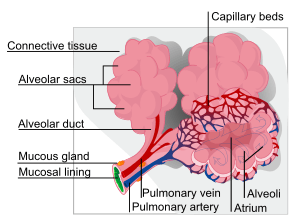Alveolar lung disease
Alveolar lung diseases, are a group of diseases that mainly affect the alveoli of the lungs.[1]
| Alveolar lung disease | |
|---|---|
 | |
| Alveolus | |
| Specialty | Pulmonology |
Causes
Alveolar lung disease may be divided into acute or chronic. Causes of acute alveolar lung disease include pulmonary edema (cardiogenic or neurogenic), pneumonia (bacterial or viral), pulmonary embolism, systemic lupus erythematosus, bleeding in the lungs (e.g., Goodpasture syndrome), idiopathic pulmonary hemosiderosis, and granulomatosis with polyangiitis.
Chronic alveolar lung disease can be caused by pulmonary alveolar proteinosis, alveolar cell carcinoma, mineral oil pneumonia, sarcoidosis (alveolar form), lymphoma, tuberculosis, metastases, or desquamative interstitial pneumonia.
Diagnosis
Alveolar disease is visible on chest radiography as small, ill-defined nodules of homogeneous density centered on the acini or bronchioles. The nodules coalesce early in the course of disease, such that the nodules may only be seen as soft fluffy edges in the periphery.
When the nodules are centered on the hilar regions, the chest x-ray may develop what is called the "butterfly," or "batwing" appearance. The nodules may also have a segmental or lobar distribution. Air alveolograms and air bronchograms can also be seen.
These findings appear soon after the onset of symptoms and change rapidly thereafter.
A segmental or lobar pattern may be apparent after aspiration pneumonia, atelectasis, lung contusion, localized pulmonary edema, obstructive pneumonia, pneumonia, pulmonary embolism with infarction, or tuberculosis.
Treatment
References
- Al-Tubaikh, JA (2010). "Chapter 3.2 Alveolar lung diseases". Internal Medicine. Springer. p. 113. ISBN 978-3642037085.